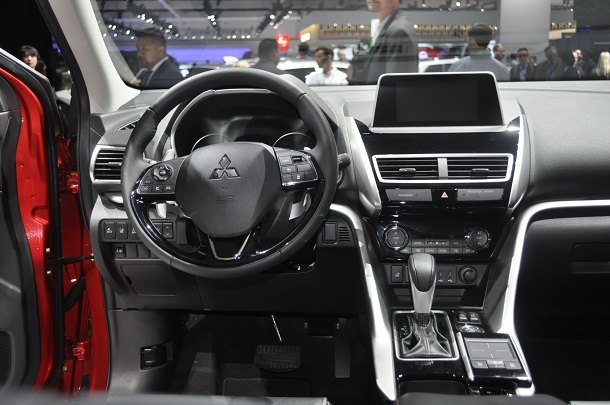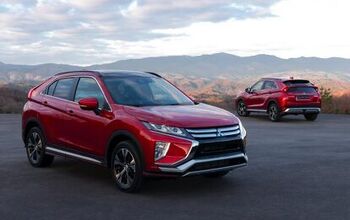2018 Mitsubishi Eclipse Cross - The Disappointment Continues

Let’s start this with a disclaimer – it’s always a gamble to rip on a car one has yet to drive. I could end up eating these words someday if I drive the Eclipse Cross and like it. Which, of course, is absolutely possible.
Still, I don’t feel it’s entirely unfair to judge a vehicle based on observations gleaned from an auto show display, as well as from the on-paper specs. Not so long as you disclose, as I did just now, that the assessment is subject to further examination. Hell, if it was unfair, auto journalists would have one less type of story to write after each show.
As I write this, it’s been only about a day since I was on the show floor in Los Angeles, and I am still trying to sort through my feelings about the most-important unveilings. The Subaru Ascent is bland but will sell like proverbial hotcakes, the three-row Lexus RX caused me a bit of eye-roll but the two-row LX is intriguing, the Mazda 6 hasn’t changed enough but turbo power sounds good, and I somehow never saw the new Corvette ZR1. Also, I really hope Toyota builds the FT-AC concept, and I am not sure how to feel about Nissan and its pumped-up Kicks.
Then there’s the Eclipse Cross. That name has been known for some time, and it makes me growly – I don’t like the Eclipse name being applied to another generic crossover. Yes, the last Eclipse sports car was bad (a harbinger of things to come, it turns out) and sure, from a business perspective it makes sense, but I don’t have to like it. I get that Mitsu owns the name and knows it has cachet with buyers over a certain age (not coincidentally, many of whom now have families and a need for a crossover), so it makes sense, but I still have the right to be grumpy about it.
Complaints about the name aside, I was still curious. Maybe it wouldn’t suck! Maybe us auto critics were pre-judging unfairly based on the brand’s recent struggles and past history of cars that either underwhelm (Lancer) or do just one thing well (Evo). Maybe we’re too harsh on the Mirage, which isn’t great, but appeals to those who can’t afford much else, thus fulfilling its mission.
Mitsubishi’s recent track record isn’t good, but struggling companies can turn themselves around. Hyundai did it, so did Kia. So did Mazda. All of the Detroit automakers have had periods of dark days followed by eras of strength, save perhaps the perpetually troubled Chrysler (now FCA), which always seems to hang on through the strength of one or two brands propping up the rest of the company.
It takes time, sure, but it usually starts with one model. And while Mitsu’s current crossover offerings, the Outlander and Outlander Sport, are far from the best buys in the class, they are not without some decent qualities. So perhaps the Eclipse Cross could mark the start of a turnaround.
When I arrived at the Mitsubishi booth shortly after the unveiling (a few minutes late, thanks to the Jeep Wrangler madness happening nearby), I initially had a positive reaction – the exterior styling, while fitting the crossover mold to a T, was better-looking in the flesh than I anticipated. Not head-turning, but it looked like the designers understand what works in the crossover market in 2017.
Then the door opened. I didn’t get close for long – just a quick pop into the cabin to snap a few pics – but I could see a touchpad infotainment controller, a la the much-loathed unit that Lexus uses. Atop the center stack sits a tacked-on display screen of the type that’s common across the industry. While it’s personal preference and not all will agree, I am not a fan of these chintzy-looking displays. Integrated just looks better.
The rest of the cabin was marred with dull gray and black tones, and didn’t look particularly advanced over what Mitsubishi currently offers. The layout looks logical, at least, but on first glance that’s about the nicest thing I can say.
That’s a problem for a brand that’s recently been sort of the forgotten stepchild of the industry. A turnaround will take time and a clear strategy. Mitsubishi doesn’t seem to have the latter and it’s unclear how much of the former the parent company will allow it.
If Mitsubishi was going to follow in the steps of other brands who have gone from afterthoughts to part of the conversation, a strong effort on the Eclipse Cross would be a good start. So far, that doesn’t appear to be the case.
Credit where credit is due – a quick scan of the press release indicates that at least the available features are class-competitive, and the Eclipse Cross does start at a reasonable $23,295 before D and D. So, as with the Outlander – which also starts at about the same price – the Eclipse Cross will have appeal to value shoppers.
The thing is, that’s not enough. Mitsubishi can continue to chase value buyers, and it won’t grow as a brand. At some point, the company is going to have to add other vehicles to the lineup that appeal on more than just being cheap. That’s how other brands have grown, even as those brands continue to offer affordable vehicles in classes where so doing makes sense.
Instead, we get this. A five-seat compact crossover that doesn’t move the needle and offers one less seating row than the Outlander for similar money, while also costing a little more than the five-seat Outlander Sport.
I don’t know what Mitsubishi is doing, but if the brand really wants to regain the market position it once held, this doesn’t appear to be the right way to do it.
[Images © 2017 Tim Healey/TTAC]

Tim Healey grew up around the auto-parts business and has always had a love for cars — his parents joke his first word was “‘Vette”. Despite this, he wanted to pursue a career in sports writing but he ended up falling semi-accidentally into the automotive-journalism industry, first at Consumer Guide Automotive and later at Web2Carz.com. He also worked as an industry analyst at Mintel Group and freelanced for About.com, CarFax, Vehix.com, High Gear Media, Torque News, FutureCar.com, Cars.com, among others, and of course Vertical Scope sites such as AutoGuide.com, Off-Road.com, and HybridCars.com. He’s an urbanite and as such, doesn’t need a daily driver, but if he had one, it would be compact, sporty, and have a manual transmission.
More by Tim Healey
Latest Car Reviews
Read moreLatest Product Reviews
Read moreRecent Comments
- Bkojote Allright, actual person who knows trucks here, the article gets it a bit wrong.First off, the Maverick is not at all comparable to a Tacoma just because they're both Hybrids. Or lemme be blunt, the butch-est non-hybrid Maverick Tremor is suitable for 2/10 difficulty trails, a Trailhunter is for about 5/10 or maybe 6/10, just about the upper end of any stock vehicle you're buying from the factory. Aside from a Sasquatch Bronco or Rubicon Jeep Wrangler you're looking at something you're towing back if you want more capability (or perhaps something you /wish/ you were towing back.)Now, where the real world difference should play out is on the trail, where a lot of low speed crawling usually saps efficiency, especially when loaded to the gills. Real world MPG from a 4Runner is about 12-13mpg, So if this loaded-with-overlander-catalog Trailhunter is still pulling in the 20's - or even 18-19, that's a massive improvement.
- Lou_BC "That’s expensive for a midsize pickup" All of the "offroad" midsize trucks fall in that 65k USD range. The ZR2 is probably the cheapest ( without Bison option).
- Lou_BC There are a few in my town. They come out on sunny days. I'd rather spend $29k on a square body Chevy
- Lou_BC I had a 2010 Ford F150 and 2010 Toyota Sienna. The F150 went through 3 sets of brakes and Sienna 2 sets. Similar mileage and 10 year span.4 sets tires on F150. Truck needed a set of rear shocks and front axle seals. The solenoid in the T-case was replaced under warranty. I replaced a "blend door motor" on heater. Sienna needed a water pump and heater blower both on warranty. One TSB then recall on spare tire cable. Has a limp mode due to an engine sensor failure. At 11 years old I had to replace clutch pack in rear diff F150. My ZR2 diesel at 55,000 km. Needs new tires. Duratrac's worn and chewed up. Needed front end alignment (1st time ever on any truck I've owned).Rear brakes worn out. Left pads were to metal. Chevy rear brakes don't like offroad. Weird "inside out" dents in a few spots rear fenders. Typically GM can't really build an offroad truck issue. They won't warranty. Has fender-well liners. Tore off one rear shock protector. Was cheaper to order from GM warehouse through parts supplier than through Chevy dealer. Lots of squeaks and rattles. Infotainment has crashed a few times. Seat heater modual was on recall. One of those post sale retrofit.Local dealer is horrific. If my son can't service or repair it, I'll drive 120 km to the next town. 1st and last Chevy. Love the drivetrain and suspension. Fit and finish mediocre. Dealer sucks.
- MaintenanceCosts You expect everything on Amazon and eBay to be fake, but it's a shame to see fake stuff on Summit Racing. Glad they pulled it.





































Comments
Join the conversation
Before buying into Mitsubish one should check on resale/trade in values of the cars. In my market the depreciation rate is staggering.
They definitely know how to ruin a car that's all I got to say 2G DSM 4 Life